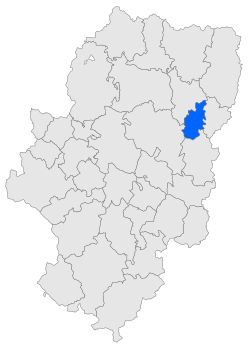Monzón
Monzón | |
|---|---|
 The castle in Monzón. | |
 The comarca of Cinca Medio, of which the capital in Monzón, within Aragon. | |
| Country | |
| Autonomous community | |
| Province | Huesca |
| Comarca | Cinca Medio |
| Government | |
| • Alcalde | Fernando Heras Laderas (PSOE) |
| Area | |
| • Total | 155.01 km2 (59.85 sq mi) |
| Elevation | 273 m (896 ft) |
| Population | |
| • Total | 17,042 |
| • Density | 110/km2 (280/sq mi) |
| Demonym | Montisonense |
| Time zone | UTC+1 (CET) |
| • Summer (DST) | UTC+2 (CEST) |
| Postal code | 22400 |
| Website | Official website |
Monzón is a small town in the autonomous community of Aragon, Spain. It has a population of 17,050. It is located in the northeast (specifically the Cinca Medio district of the province of Huesca) and adjoins the rivers Cinca and Sosa.
Historical overview
Monzón is notable because of its relationship with the Knights Templar and for its role as a parliamentary centre in the Crown of Aragon, between the 13th and 17th centuries. The different realms of the Crown of Aragon each had their own laws and parliaments, but it was often convenient to hold joint sessions of a "general parliament" as Monzón was an important staging post between Zaragoza and Barcelona, it was the usual location for such meetings.

Also noteworthy is the cathedral of Santa María del Romeral (Saint Mary of the Rosemary Field), with Romanic basements and the castle, originally from the 9th century (Torre del Homenaje) which hosted kings and nobles. It was here in 1109 that Urraca of Castile married her second husband Alfonso I "The Battler" despite the objections of the Church. Child-king James I "The Conqueror" spent part of his youth there, after his father Peter II "The Catholic" died in the Battle of Muret (1213); James I was kept under guardianship by the Knights Templar in Monzon, a strategic spot between Segre and Cinca valleys.
Cardinal Richelieu and Gaspar de Guzmán, Count-Duke of Olivares signed a treaty here, ending the conflict over Valtelline in 1626.
Famous Sportsmen
Monzón has been home to great sportsmen and women well known to the Aragonese and the world. Among them are Conchita Martínez, the only Spanish woman to win the most important and ancient tournament in tennis, Wimbledon, and Eliseo Martín, bronze medal winner in the 3000m steeplechase in the Paris World Championships (2003) - the only non African athlete to get a medal in those Champìonships since 1993.
But Monzon has also been home to Olympic athletes, including Javier Moracho (110 m hurdles) - Spanish record holder for almost 20 years - the decathlete Álvaro Burrell, and the renowned pole vaulter Javier Gazol.
Places of interest
- El Castillo Templario (The Castle of the Knights Templar)
- La Catedral de Santa María del Romeral (The Cathedral of Saint Mary of the Rosemary Field, 12th and 13th centuries).
- El Convento de San Francisco (Saint Francis Convent, now dedicated to musical education).
- La Ermita de la Virgen de la Alegría (The Happiness Virgin Shrine, from the 17th century).
- Major House (16th and 17th centuries).
- La Puerta de Luzán (Luzán Gate).
Notable people from Monzón
- Carlota Gago Peiron (born 1985)
- Conchita Martínez (born 1972) Former tennis player and Wimbledon Champion in 1994
- Barón de Eroles (1860–1941): lawyer and philanthropist who brought to Monzón one of the first X-Ray machines in Spain.
- Reverendo Vicente Pilzano y Ezquerra: prior to the 18th century, he wrote important chronicles about the city.
- Ignacio de Luzán (1702–54): her poetry is still studied in universities all around the world.
- José Mor de Fuentes: naval engineer and writer, author of books including ‘’La Serafina’’, ‘’La fonda de París’’, ‘’El calavera’’, ‘’A la muerte de Lord Byron’’, ‘’Los nuevos desengaños’’.
- Joaquín Costa y Martínez (1846–1911): One of the greatest men of the ‘’Regeneracionismo’’. He developed theories about education, water management and agricultural politics that were followed throughout the 20th century. "Oligarquía y Caciquismo" is one of his best books.
- Mariano de Pano y Ruata (1847–1948): He was president of the ‘’Ateneo’’ and ‘‘Academia de Bellas Artes de San Luis’’. He was the official Chronicler of the monasterio de Sijena and of the Real Academia de la Historia. His best books are: ‘’Las coplas del Peregrino’’, ‘’Puey de Monzón’’, ‘’Viaje a la Meca en el siglo XVI’’ and ‘’La condesa de Bureta doña Consolidación de Azlor’’.
- Joaquín de Pano y Ruata (1849–1919): engineer, ornythologist, filologue, translator of several languages, including Chinese and Japanese. He designed bridges in Monzón and one of them served as the model for bridges in Zaragoza.
Notes and references


